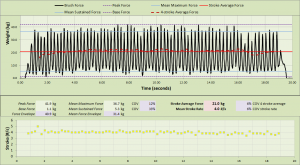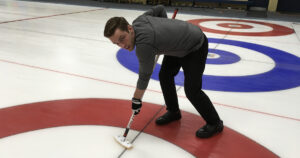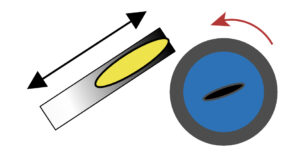Blog

The Anatomy of a Brush Stroke
This article is joint work with Professor of Engineering John Newhook of Dalhousie University in Halifax. Click on the image above to view the PDF. In 2018 we documented the vertical forces and other characteristics of a brush stroke in order to better convey our understanding of the mechanics of brushing and how we might use this information to improve the coaching of the sport. This article, the first in our Technical Coach Series, is certainly not the first to document the variability in the forces achieved when brushing. To our knowledge, it would appear that researchers in the School of Engineering at the University of Edinburgh (B.A. Marmo, I.S. Farrow, M-P Buckingham, and J.R. Blackford) were the first to document the variability of forces during a brush stroke, and how these forces are generated on the ice, in various papers in 2005-2006 (see references below). Their results were later confirmed by other researchers in 2010-2012 in both Canada and

Curling brushes – Try before you buy – Part Un
No self-respecting golfer would simply walk into a golf pro shop or retail outlet to buy a new set of clubs without going through the process of getting fitted. Fitting is an assessment process that involves the analysis of a golfer’s swing and physiology to ensure that the golf clubs under consideration “fit” the player, enabling the player to strike the ball square in the middle of the club face with a shaft whose flex matches the player’s swing speed, among other trade-offs. A summary of factors involved in golf club fitting can be found in this article entitled “Clubfitting 101” by MyGolfSpy. While the MyGolfSpy article covers the details of club head variations that can suit different types of players and their style of game, the article also covers consideration of the choice of club shafts, particularly: shaft flex. Simplistically, higher swing speeds warrant stiffer club shafts though this is an overgeneralization. Other factors include release pattern and shaft

Some thoughts on practice for student-athletes
To achieve sufficient skill as a competitive student-athlete, coaches will often recommend or insist that athletes spend a certain amount of time practicing on their own. Sometimes this practice will be done with a partner, perhaps even with the entire team, or sometimes the student-athlete may prefer to work on their own. The point here is that the practice is self-directed – it’s not undertaken with the supervision of a coach. So what should this practice look like? I think that many student-athletes have actually little idea about what a self-directed practice should entail. When I’m at my local club I frequently see the following: If the practice involves multiple teammates there is often far too much unproductive chit-chat. Sometimes those conversations can be helpful, say to address a team dynamics issue, but far too often I will overhear conversations that would better be held off the ice, rather than use expensive ice-time. If you feel somewhat guilty reading this,

Pressure distribution in selected curling brush heads
This research is joint work with Dr. John Newhook, Dr. Michel Ladouceur, and Dr. Ryan Frayne of Dalhousie University in Halifax. John is a Professor of Civil Engineering and the Dean of Engineering at Dalhousie, while Michel and Ryan are assistant professors in the Kinesiology department of the School of Health and Human Performance at Dalhousie. At the 2022 North American Conference on Biomechanics (NACOB) held the week of August 22-25 in Ottawa, we presented our initial work that compared a variety of commercial brush heads in how they distributed pressure across their pads in a static laboratory setup. Forces and pressures were recorded using two 3200E Tekscan (Tekscan Inc., Boston, MA) pressure sensors affixed to the top of an AMTI BP400600 force plate (AMTI Inc., Watertown MA), with the sensel areas abutted. CONFORMat Research software (version 7.1: Tekscan Inc.) was used to collect the pressure sensor data, which was recorded at a frequency of 100 Hz. Our results are

Does brushing with a brush turned to 90 degrees really work?
Recently I’ve received numerous inquiries regarding teams rotating their brush heads 90 degrees when attempting to “carve” a stone (accentuate curl). Some tour players, as well as commentators, have adopted the term “knifing” for this tactic. As of the date of this post – 26 March 2022 – I’ve probably been asked the question at least twenty times and so, rather than continue to respond individually to each questioner, I decided to post this short article. As usual, this post is joint work with my research colleague John Newhook of Dalhousie University in Halifax. Short answer The question isn’t, really, whether or not using a brush head turned 90 degrees “works”. Applying brushing forces – and hence thermal energy – to the ice on one side of a stone over the other is going to have an effect on a stone’s trajectory. The actual question to be answered is under what conditions is brushing using a brush head turned 90

Zeroing a PT-2 Smartbroom
Even though the PT-2 has been discontinued by Canadian Curling Tools in favour of their new “Smartbroom” device, a number of curling associations and individual coaches continue to use PT-2 instrumented brushes with their teams. A characteristic of the PT-2 that coaches must be aware of is the frequent need to “zero” the PT-2 brush to ensure that the force readings from the brush are as accurate as possible. The need for this is because the PT-2’s load sensors are cemented into the brush’s EQ brush pad, and over-tightening of the bolts that fix the brush pad in place can result in skewed measurements. As I’ve been asked a few times about the zeroing method for the PT-2 I decided to post this article. PT-2 documentation is no longer available on the Canadian Curling Tools website. To zero a PT-2 brush, follow these steps: Ensure that the brush head is plugged into the PT-2’s display unit, and the unit is